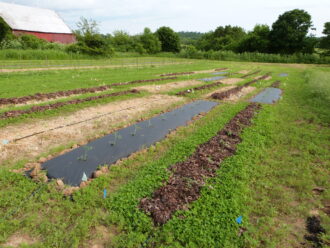A mulch made with cover crop residue can help suppress weeds while building soil health. In Indiana, two tomato growers have teamed up with researchers and tomato growers at the Indiana University farm to experiment with mulch that combines leaf and cover crop residues. They're working towards a mulch strategy that leads to improved soil health and salable yields of tomatoes.
“Mulches created from nitrogen-fixing cover crops, such as white clover and hairy vetch, are particularly attractive for nitrogen-demanding crops such as tomato, and in-row leaf mulch strips show promise for mitigating cover crop challenges,” said Indiana University researcher and tomato grower Heather Reynolds. “Yet reliability and convenience often turns farmers to plastic mulch, a fossil-fuel intensive product that generates substantial landfill waste, and helps retain but does not build soil nutrients or organic matter. Straw is another common mulch choice, but can contain weed seed, promote mold, and lead to crop nitrogen deficits.”
With support from a $28,394 NCR-SARE Partnership grant, the team tested combinations of cover crops (living white clover or residue of winter rye-hairy vetch) and in-row leaf mulch for organic fresh-market tomato production.
First, they set up replicated mulch treatments and controls at the three partner farms. Their treatments consisted of white clover living mulch or winter rye-hairy vetch residue with and without un-decomposed leaf mulch. The leaf mulch was collected from the Indiana University campus in the fall of 2018. Their controls consisted of leaf mulch by itself and the current standard practice at each farm (such as black plastic or straw).
Each farmer started their own seedlings, using either the Celebrity or Mountain Fresh variety. Tomato seedlings were planted into treatment and control beds in late May 2019. They trellised the tomatoes in early June 2019 and harvested July-September 2019. They conducted soil tests when the tomatoes were planted in May, and then again in early September.
The project is ongoing, but so far, across the three organic farms with quite different soil qualities, they have found that cover crop and leaf mulches were able to suppress weeds and build soil health.
Cover Crop Tomato Mulch Findings
- Soil health: Indicators of soil microbial health tended to be higher with alternative mulches. For example, at one farm white clover increased soil nitrogen cycling compared to plastic mulch. Likewise, indicators of soil carbon sequestration potential tended to be higher with cover crop mulches compared to plastic or straw mulches.
- Yields: Farmer’s standard weed suppression method (black landscaping fabric, black plastic film, or straw) resulted in 28-95% greater salable tomato yield at all farms compared to the treatments and control. However, when combined with leaf mulch strips, white clover living cover crops and/or rye-vetch cover crop residue tended to promote the second highest salable yields at all farms.
“Cover crop mulches outperform plastic and straw mulches in terms of indicators of soil health and carbon storage,” explained Reynolds. “And in-row leaf mulch strips show promise for mitigating cover crop challenges, but more research is needed to optimize these mulches so that they are truly competitive with conventional plastic or straw mulches.”
